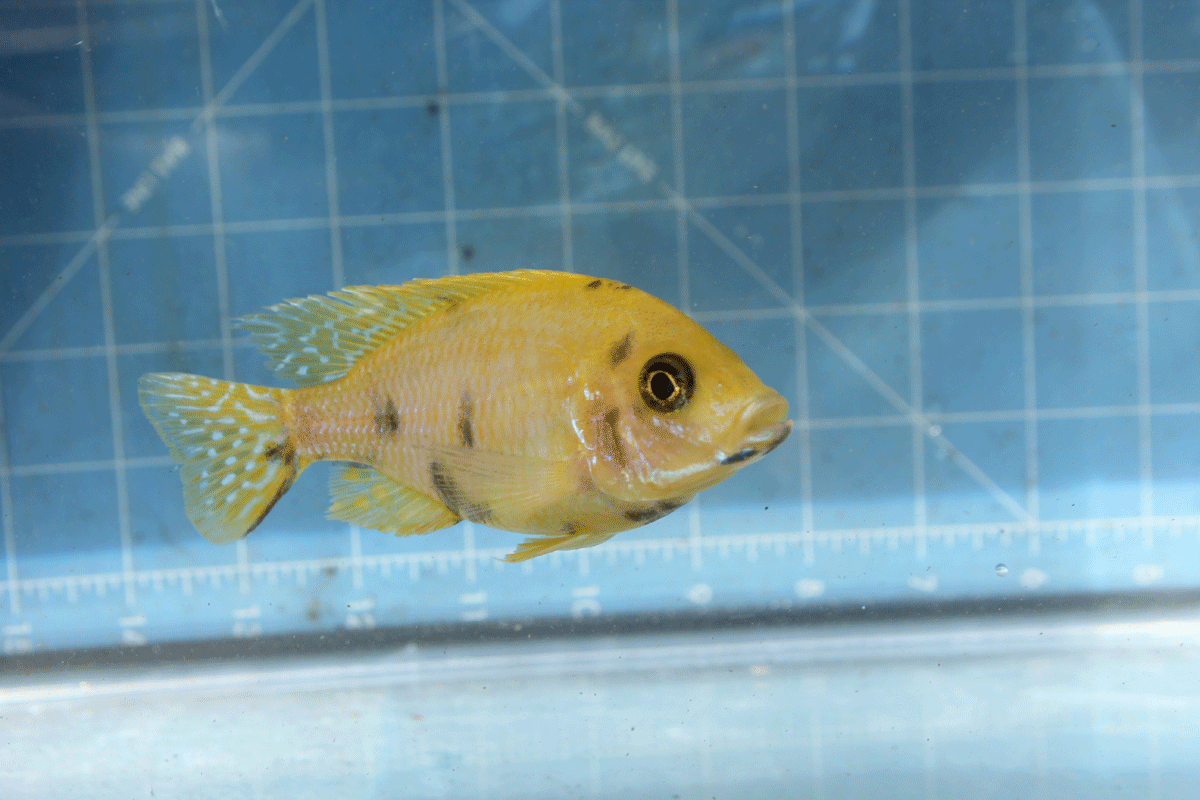Photo: A very young (about four months old) male Canary OB Peacock. By the way, while the grid behind him shows one-inch squares, he is not six inches long. He’s at the front of the aquarium and the grid is at the back. He’s actually only four inches long, barely large enough to reliably determine his sex.
In keeping with my awesome marketing and naming talents I’ve just named a new strain of OB Peacock Cichlids, the Canary OB Peacock. Why do I call it that? Well, its color reminds me of the canaries my Grandmother raised when I was a child and in the very house Susie and I now live in.
We were processing our Orange OB Peacocks (see my blog: http://goliadfarms.com/orange-ob-peacock/), when I noticed a young male that certainly wasn’t an Orange OB but had a pleasing coloration. I set him aside. While sorting females to add to the Orange OB breeding colony, I found eleven females sort of matching the male’s coloration. They were also set aside.
After finishing with the Orange OBs, I consulted with Susie (wife and business manager) about setting up these twelve fish in a 300 gallon breeding vat. Now Susie takes a dim view of fish she calls “Charles’ experimentals”. She has a worldview that calls for each of our vats to yield a certain amount of revenue per year. She claims that my experimentals rarely or maybe never achieve this goal. I, on the other hand, basically live for the experimentals. I like creating new strains or improving existing strains of plants and animals, especially fish. I continuously remind her of the experimentals that went on to become bread-and-butter sales. She scoffs and says those can be counted on some fingers of one hand. I then point out the various Peacock cichlid strains that were once experimentals but now provide a steady revenue stream (see my blog about the development of some of our Peacocks at: http://goliadfarms.com/our-peacock-cichlids/). She reluctantly gives me that but with an eye-roll reminding me of our children. I wonder where they got that.
All of this said, Susie agreed the male was nice and I had her approval for the use of the 300 gallon vat. It was only available because I had very reluctantly ended an earlier experimental strain that hadn’t worked out as well as I had promised. In any event, the vat was available. All I can say is the little male had better produce!
What is my plan for him besides giving him eleven females and 300 gallon vat? Well, in about three months I’ll break down that vat and inventory his offspring. He’s young and some of the females he got are larger than him, so I don’t think I’ll get a huge number of fry. Nevertheless, I’ll sort those offspring into two groups, less than two inches and over two inches. Each of these groups will be placed in a 55 gallon to grow up. I’m hoping for a hundred or so of each size. That might seem like a large number of fish to place in a 55 gallon vat, but we routinely put 300 in a vat to grow up. Our recirculating system with plant filtration (see my blogs about this at: http://goliadfarms.com/plant-filtration/ and http://goliadfarms.com/about/our-methods/) allows us to crowd fish. There are some advantages to crowding beyond being able to produce large numbers of fish in a small space. One is the fish are much more aggressive about eating when crowded and much less aggressive to each other. In another three months these fish will be young adults and I’ll put aside the ones closest to canaries in color as potential breeders. By that time the original breeding colony will be ready to process again. I’ll compare the original breeders to the potential breeders. If the original male is still best he’ll be retained. I might add one of the best of his sons to the breeding colony if one is as good as he is. If one or two sons are best, then he’ll be replaced (this is very Darwinian don’t you think?). The same goes for the females. If enough are “good enough,” meaning look like my concept of Canary OBs, then I’ll bring the colony up to full strength with 40 to 60 females.
This process will continue breeding cycle after cycle until I have a strain that mainly breeds true, although it’s often the non-true breeding fish that form the basis for another “experimental” strain.
Good fishkeeping!


Leave a Reply